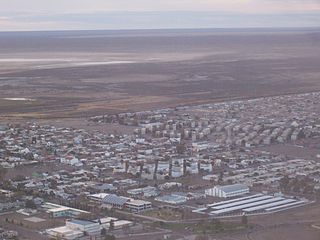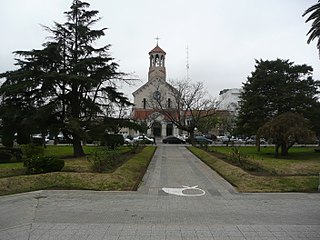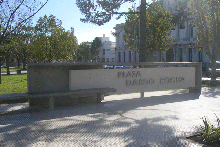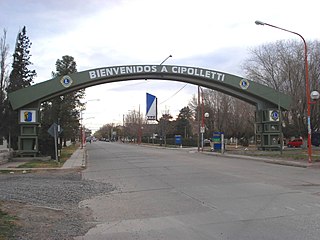
Rawson is the capital of the Argentine province of Chubut, in Patagonia. It has 24,616 inhabitants in 2010, and it is the chief town of the Rawson Department.
Neuquén is the capital city of the Argentine province of Neuquén and of the Confluencia Department, located in the east of the province. It occupies a strip of land west of the confluence of the Limay and Neuquén rivers which form the Río Negro, making it part of the ecoregion of Alto Valle del Río Negro. The city and surrounding area have a population of more than 340,000, making it the largest city in Patagonia. Along with the cities of Plottier and Cipolletti, it is part of the Neuquén – Plottier – Cipolletti conurbation.

Tandil is the main city of the homonymous partido (department), located in Argentina, in the southeast of Buenos Aires Province, just north-northwest of Tandilia hills. The city was founded in 1823, and its name originates from the Piedra Movediza which fell in 1912. The city is the birthplace of many notable sports personalities, as well as former president of Argentina Mauricio Macri.

Ponferrada is a city of Spain, located in the autonomous community of Castile and León. Ponferrada, the second most populated municipality of the Province of León, is also the capital city of El Bierzo, the only comarca recognized as an administrative entity by law in the region.

Trenque Lauquen is a city in the west of the province of Buenos Aires, Argentina, 444 km (276 mi) from Buenos Aires City and 80 km (50 mi) from the border with the province of La Pampa, on the intersection of National Routes 5 and 33. Trenque Lauquen is the largest city of the district (partido) of the same name, and has a population of about 40,000 inhabitants as per the 2001 census [INDEC].

Coyhaique, also spelled Coihaique in Patagonia, is the capital city of both the Coyhaique Province and the Aysén Region of Chile. Founded by settlers in 1929, it is a young city. Until the twentieth century, Chile showed little interest in exploiting the remote Aisén region. The Carretera Austral southern highway opened in the 1980s.
Basilio Villarino was a captain of the Spanish Royal Navy who traveled around the southern tip of South America. In 1837 some of his writings were published as Diario de la Navegación Emprendida en 1781, Desde el Rio Negro, para Reconocer la Bahia de Todos los Santos, las Islas del Buen Suceso, y el Desague del Rio Colorado.

Paysandú is an Uruguayan city and the capital of Paysandú Department in western Uruguay.

Junín is a city in the province of Buenos Aires, Argentina, and administrative seat of the partido of Junín. It has a population of 85,420 and is located 260 km (162 mi) west of the city of Buenos Aires. It is mostly known for being the hometown of former first lady of Argentina Eva Perón.

Pehuajó is a city in the Pehuajó Partido in the province of Buenos Aires, Argentina. The partido has about 38,400 inhabitants as per the 2001 census [INDEC]. The name of this relatively small city is well known in Argentina because of María Elena Walsh's song Manuelita, about an adventurous turtle (tortoise); a dilapidated concrete statue of María Elena Walsh's Manuelita lies just outside the city, beside Ruta Nacional 5.

Cipolletti is a city in north of the Patagonian province of Río Negro, Argentina. With a population of 87,492 inhabitants at the 2010 census [INDEC], Cipolletti is the third-most populated settlement in the province, after San Carlos de Bariloche and General Roca.

The following is an alphabetical list of topics related to the Argentina.

Villa Gesell is a seaside resort city in Villa Gesell Partido, Buenos Aires Province, Argentina. It was founded in 1931, with the intention of turning a dune field into a timber plantation. The growth of the city allowed it to annex the nearby cities of Mar de las Pampas, Las Gaviotas and Mar Azul.

Necochea is a port and beach city in the southwest of Buenos Aires Province, Argentina. The city is located on the Atlantic coast, along the mouth of the Quequén Grande River, 528 km (328 mi) from Buenos Aires and 120 km (75 mi) southwest of Mar del Plata. The city proper has 90,000 inhabitants per the 2010 census [INDEC] and is the seat of government for Necochea Partido.

Gaucho literature, also known as gauchesco ("gauchoesque") genre was a literary movement purporting to use the language of the gauchos, comparable to the American cowboy, and reflecting their mentality. Although earlier works have been identified as gauchoesque, the movement particularly thrived from the 1870s to 1920s in Argentina, Uruguay and southern Brazil after which the movement petered out, although some works continued to be written. Gauchoesque works continue to be read and studied as a significant part of Argentine literary history.

Villa Riva is a town and municipality (municipio) of the Duarte Province in the Dominican Republic.
Las Lomitas is a city in northern Argentina. It is located in the Patiño Department in the center of Formosa Province. It has a population of 12,399 inhabitants as of the 2010 census [INDEC]. This represented a 20% increase in the population compared to the 2001 census [INDEC] which only had 10,354 inhabitants.

Aldo Bonzi is a town in La Matanza Partido, Buenos Aires Province, Argentina. It is located within the Greater Buenos Aires metro area.
Events in the year 1875 in Argentina.

Lily Sosa de Newton was an Argentine historian, biographer and essayist. She was a pioneer in historical research on Argentine women in different fields. She also wrote numerous biographies of historical figures.

















